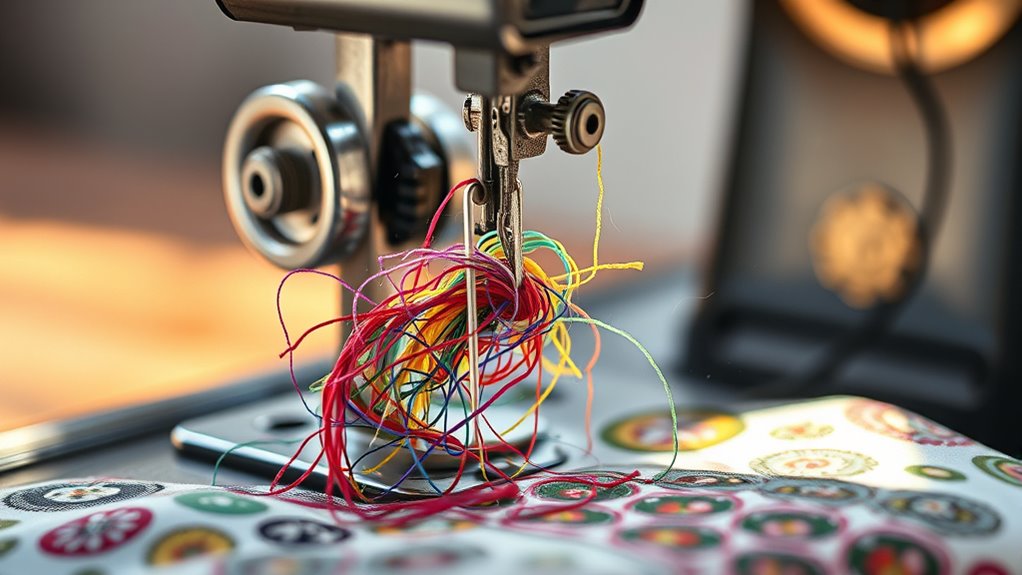Your sewing machine might get stuck due to improper thread tension, motor issues, or debris buildup. First, check the bobbin and make certain the upper thread tension isn’t too tight, as this can cause jams. Inspect the needle for any bends or breaks and guarantee proper lubrication of moving parts. Regular maintenance, such as cleaning and oiling, is vital for smooth operation. Understanding these aspects will keep your projects on track, and there’s more to uncover to enhance your sewing experience.
Common Causes of Sewing Machine Malfunctions
When your sewing machine suddenly stops functioning as expected, it can be frustrating, especially if you’re in the middle of a project. One common cause of malfunctions is improper thread tension. If the tension is too tight or too loose, it can lead to uneven stitching or thread breakage. Always check the tension settings based on the fabric and thread type you’re using.
Another issue could be motor-related. If the machine’s motor isn’t running smoothly, it may be due to a jammed mechanism or worn-out components. Listen for unusual noises, which can indicate motor issues. Regular maintenance, like cleaning and oiling, can help prevent these problems. Addressing thread tension and motor issues promptly can keep your sewing projects on track.
Troubleshooting Tips for Stuck Machines
If your sewing machine is stuck, don’t panic; there are several troubleshooting steps you can take to resolve the issue.
First, check for bobbin issues. Remove the bobbin and make sure it’s wound correctly and seated properly. A misaligned or incorrectly threaded bobbin can cause jams.
Next, inspect the upper thread tension. If the tension is too tight, it can lead to thread breakage or machine stalling. Adjust the tension dial gradually, testing as you go.
Additionally, examine the needle for bends or breaks, as these can contribute to problems. Finally, clean the machine from lint and debris, which can obstruct moving parts.
Preventative Maintenance for Smooth Operation
To guarantee your sewing machine operates smoothly, regular preventative maintenance is essential.
Start with regular cleaning; dust and lint can accumulate in the bobbin case and feed dogs, causing operation issues. Use a soft brush and vacuum attachment to remove debris effectively.
Next, employ proper lubrication techniques; consult your machine’s manual for specific oil points. Generally, applying a few drops of sewing machine oil to moving parts will enhance performance.
Avoid over-lubricating, as excess oil can attract more dirt. Finally, check the needle and thread regularly to verify they’re appropriate for your projects.
When to Seek Professional Help
Although regular maintenance can resolve many issues, there are times when seeking professional help becomes necessary. If you notice persistent signs of malfunction, such as unusual noises, skipped stitches, or the machine not feeding fabric properly, it’s essential to act.
Don’t ignore these indicators, as they may lead to more significant damage. Additionally, if your sewing machine displays error codes you can’t troubleshoot, it’s time to repair.
Waiting too long can worsen the problem and increase repair costs. If you’ve tried basic adjustments and the issue remains unresolved, consulting a professional is the best course of action. They have the expertise and tools to diagnose and fix complex issues efficiently, ensuring your machine operates smoothly again.
Essential Tools for Home Repairs
When tackling sewing machine repairs at home, having the right tools is essential for effective troubleshooting and maintenance. Without these sewing essentials, you might struggle with common issues. Here’s a list of must-have tools to streamline your repair techniques:
- Screwdrivers: Essential for removing and securing screws.
- Tweezers: Helpful for grabbing small parts and threads.
- Seam ripper: Perfect for correcting mistakes without damaging fabric.
- Oiling tools: Keeps your machine running smoothly.
Ensure you have these tools handy to address any sewing machine problems efficiently. They’ll empower you to perform necessary maintenance and repairs, enhancing your machine’s longevity and performance. With the right equipment, you’ll tackle sewing machine issues with confidence.
Frequently Asked Questions
Can Thread Type Affect Sewing Machine Performance?
Yes, thread type can affect your sewing machine’s performance. It influences thread tension and needle compatibility. Using the wrong thread can lead to issues like skipped stitches or thread breakage, impacting your overall sewing experience.
How Often Should I Oil My Sewing Machine?
You should oil your sewing machine every 30 days or after every eight hours of use. Regular oil maintenance enhances machine longevity, ensuring smooth operation and reducing wear on internal components for peak performance.
What Is the Best Way to Store My Sewing Machine?
For proper storage, keep your sewing machine in a protective case or cover. Make certain it’s clean and dry, and store it in a stable environment away from extreme temperatures or humidity to maintain ideal machine protection.
Are There Specific Fabrics That Cause More Jams?
Yes, thicker fabrics and slippery materials can cause more jams. When sewing, make certain the fabric’s thickness is compatible with your machine’s needle and settings, and avoid overly slick materials that may slip through the feed dogs improperly.
Can Sewing Machine Age Impact Its Performance?
Yes, a sewing machine’s age can impact its performance. Regular machine maintenance is essential; neglect can lead to performance decline. Over time, parts wear out, affecting stitch quality and causing potential jams or malfunctions.


